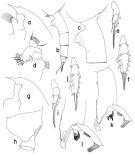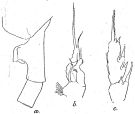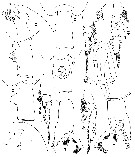|
|
 |
|
Calanoida ( Order ) |
|
|
|
Clausocalanoidea ( Superfamily ) |
|
|
|
Euchaetidae ( Family ) |
|
|
|
Paraeuchaeta ( Genus ) |
|
|
| |
Paraeuchaeta gracilicauda A. Scott, 1909 (F,M) | |
| | | | | | | Syn.: | Euchaeta gracilicauda : Vervoort, 1957 (p.77);
No Euchaeta gracilicauda : Sewell, 1929 (p.160, figs.F); no Grice & Hulsemann, 1968 (tab.2); 1969
Euchaeta gracilicauda : Park, 1975 c (p.13, figs.F,M, Rem.) | | | | Ref.: | | | A. Scott, 1909 (p.72, Descr.F, figs.F); Park, 1994 (p.322, 327, biogéo); 1995 (p.61, Rem.F,M, figs.F,M) |  issued from : T. Park in Bull. Scripps Inst. Oceanogr. Univ. California, San Diego, 1995, 29. [p.165, Fig.55]. Female: a, forehead (left side); b, urosome (left); c, genital somite (left); d, Mx1 (first inner lobe omitted), posterior; e, exopod of P1 (anterior); f, exopod of P2 (anterior). Nota: Laterally, rostrum of long spiniform, pointing obliquely forward in parallel to anterodorsal margin of forehead. Genital somite including prominence with a depth-length ratio of about 100:151, with smoothly and broadly curvrd dorsal margin. Genital flange with nearly straight ventral margin and produced distally into a large conical posterior lobe. Posterior edge of genital field extending far beyond genital flange but not projecting into a lobe similar to posterior lobe of genital flange as in P. vorax. Posterior margin of genital prominence smoothly and indistinguishably curving into ventral wall of somite. A low ridge is found on left side of genital somite posterior to genital prominence and close to ventral wall of somite (easily seen when the somite is tilted). Cephalosomal appendages as in P. malayensis except that outer lobe of Mx1 with 5 long setae. In P1 exopod, outer margin of 1st segment strongly bulging and outer spine very small. Male: g, forehead (left); h, last pedigerous and genital somites (left); i, exopod of P1 (anterior); j, exopod of P2 (anterior); k, distal exopodal segments of left 5th leg (anterior, tilted counterclockwise); l, idem (lateral).
|
 issued from : R.B.S. Sewell in Mem. Indian Mus., 1929, X. [p.160, Fig.61]. Very doubtful. Female (from off SE Sri-Lanka): a, posterior thoracic margin and genital segment (lateral left side); b, P1; c, P2 (exopodal segments 2 and 3)
|
 issued from : A. Scott in Siboga-Expedition, 1909, XIX a. [Plate XVIII, Figs.9-16]. Female (from Banda Sea): 9, habitus (dorsal); 10, forehead (lateral); 11, last thoracic and genital segments (left side); 12, A1; 13, part of one of the distal hairs of Mxp; 14, P1; 15, P2; 16, part of terminal spine (exopodite of P3).
|
 issued from : T. Park in Smiths. Contr. Zool., 1975, 196. [p.15, Fig.12]. Female (G. of Mexico): a, forehead (lateral); b, genital segment (lateral); c, same (left side viewed obliquely); d, same (dorsal); e, same (ventral); f, outer coxal lobe of Mx1; g, P1 (anterior); h, P2 (anterior). Male: i, forehead (lateral); j, P1 (anterior); k, P2 (anterior); l, P5; m, exopod of left P5 (anterior); n, same (medial). Nota:The species was collected in tows down to depths exceeding 1000 m.
|
 Paraeuchaeta gracilicauda Paraeuchaeta gracilicauda Female: 1 - See key to species Groups and independent species of Paraeuchaeta (p.30): malayensis species Group. 2 - Outer spine of 2nd exopodal segment (or the 2nd of the first 2 exopodal segments forming a proximal, compound segment) of P1 normally developed (Fig.55-e). 3 - Outer lobe of Mx1 with 5 long setae (Fig.55-e). 4 - Laterally, genital prominence low with more or less convex genital flanges (Fig.55-c). 5 - Laterally, rostrum well developed (Fig.55-a). 6 - Laterally, posterior margin of genital prominence smoothly merging into posterior ventral wall of somite (Fig.55-c). 7 - Genital somite without conspicuously ridged outgrowth on left side posterior to genital prominence (Fig.55-c). 8 - Laterally, rostrum very elongated, pointing somewhat ventrad (Fig.55-a).
| | | | | Compl. Ref.: | | | Sewell, 1948 (p.540, 552); Suarez-Morales & Gasca, 1998 a (p.109) | | | | NZ: | 7 | | |
|
Distribution map of Paraeuchaeta gracilicauda by geographical zones
|
| | | | | |  Chart of 1996 Chart of 1996 | |
 issued from : T. Park in Hydrobiologia 292/293, 1994. [Fig. 3, p.327].
Geographical distribution of Paraeuchaeta gracilicauda (lozange). issued from : T. Park in Hydrobiologia 292/293, 1994. [Fig. 3, p.327].
Geographical distribution of Paraeuchaeta gracilicauda (lozange). |
| | | | Loc: | | | G. of Mexico, Caribbean Sea, Indonesia-Malaysia, Philippines, China Seas (South China Sea), Coral Sea , Pacif (tropical), Tasman Sea, Baja California, central America | | | | N: | 3 | | | | Lg.: | | | (3) F: 7,9-6,2; M: 6,5-6,2; (5) F: 7; (19) F: 6,0-6,41; M: 6,35-6,41; {F: 6,00-7,90; M: 6,20-6,50} | | | | Rem.: | For Park (1975 c, p.16) the record from the Indian Ocean by Sewell (1929) seems to be not referable to this species, as the record by Grice & Hulsemann (1968) from the eastern South Pacific (after reexamination of the specmens, the form of the rostrum is not in agreement with P. gracilicauda).
Park (1995, p.61) found this species widely in the tropical and temperate zones of the entire Pacific including waters along the Pacific coast of America between 31°N and 13°N, the central Pacific between 31°N and 10°S, and the western Pacific including the South China Sea, Malay Archipelago, Coral Sea, and Tasman Sea between 34°N and 50°S. This is one of the Pacific species occurring in the Gulf of Mexico and Caribbean Sea but not in the rest of the Atlantic. | | | Last update : 26/08/2019 | |
|
|
 Any use of this site for a publication will be mentioned with the following reference : Any use of this site for a publication will be mentioned with the following reference :
Razouls C., Desreumaux N., Kouwenberg J. and de Bovée F., 2005-2025. - Biodiversity of Marine Planktonic Copepods (morphology, geographical distribution and biological data). Sorbonne University, CNRS. Available at http://copepodes.obs-banyuls.fr/en [Accessed November 20, 2025] © copyright 2005-2025 Sorbonne University, CNRS
|
|
 |
 |








